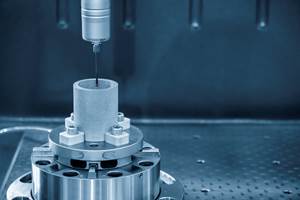Can a CNC M-Code Accelerate Laser Calibration?
A metrology technology supplier describes a technique for significantly reducing the downtime to calibrate large machines.
Share






Laser calibration of a machine tool hardly proceeds at light speed. For example, bi-directional laser calibration of just one 40-inch axis of a CNC mill might take the better part of an hour, with the machine axis moving in 10-mm increments and stopping to settle as the laser interferometer takes each reading. That pause for each reading can be as long as 23 seconds, says Renishaw, a supplier of machine calibration technology including laser systems. The cumulative effect of all of these little waits can translate to considerable downtime for calibrating a large, high-value machine tool. In some cases,—depending on machine crashes and the shop’s quality system, the company says—a critical machine might be out of action for several days per year just for this calibration. Owners of these machines are obviously very aware of the lost production.
But there is a solution, Renishaw says. A technique taking advantage of a feature in its XL80 laser interferometer reduces the settling time to just 250 milliseconds after each incremental axis move, cutting calibration time by 85 to 95 percent. In addition to returning the machine to production more quickly, this technique also better reflects axis positioning accuracy under real cutting conditions, because in real cutting, the moves are fast and the settling time is slight before the tool engages the work.
Quality Tech Services of Byron, Georgia, uses this time-saving technique with the XL80. The company has instructed new laser buyers on using it as well. Company owner Mike Schraufnagel says, “As a calibration service, the first concern we hear when we walk in the door is downtime on a machine. Customers will do anything to cut downtime on a critical asset.” His customers who own lasers themselves have employed this technique to keep their machines cutting, while his own team uses it to increase its overall efficiency. “What normally would take 30 minutes now takes just 3,” he says. “In one afternoon, we were able to complete six laser setups and three ballbar setups on a machine in 2 hours.” In the past, this work would have taken at least a day.
An M code and an open contact relay are the prerequisites that make this technique possible. To achieve the high speed calibration, the machine’s CNC uses an available M code to close a “normally open” set of relay contacts for between 10 and 20 milliseconds. If the M code to effect this trigger is not available, it might be available for purchase or activation through the OEM. Closure of the relay contacts via an auxiliary I/O cable provides a trigger for the laser to record the difference between the measurement reading and the target position.
“We identified spare relays that can be controlled via M codes on a Haas CNC machine in our lab,” explains Michael Wilm, Renishaw’s calibration business manager. Using the relays to trigger the laser interferometer and thereby reduce machine downtime was the idea that developed from this discovery. The laser simply needs to see the relay close for as little as a microsecond, but mechanical relay contacts can bounce for the first few milliseconds, he says. Therefore, “we have added a bounce rejection feature programmed into the electronics of the laser. Any chatter within 20 milliseconds gets ignored, the laser takes a reading, and the axis moves to the next measuring position.” The result is laser calibration that proceeds quickly, and more like the way the machine will move during normal production.
Related Content
Marathon Precision’s Engineering Playground: One Shop’s Secret to Sustaining High Tech, Low-Volume and High Morale
Half an airplane on the wall, a ten-foot metal dragon, and a full-blown recording studio might not scream “manufacturing efficiency,” yet Marathon Precision proves otherwise. Here’s how forging, complex CNC operations and staff-driven creative projects combine to fuel the shop’s productivity and profitability.
Read MoreHow to Choose the Correct Fixed-Body Plug Gaging Solution
The two types of fixed-body plug gages are both accurate, fast and easy to use. Consider these factors when selecting one for your gaging application.
Read More6 Machine Shop Essentials to Stay Competitive
If you want to streamline production and be competitive in the industry, you will need far more than a standard three-axis CNC mill or two-axis CNC lathe and a few measuring tools.
Read MoreParts and Programs: Setup for Success
Tips for program and work setups that can simplify adjustments and troubleshooting.
Read MoreRead Next
AMRs Are Moving Into Manufacturing: 4 Considerations for Implementation
AMRs can provide a flexible, easy-to-use automation platform so long as manufacturers choose a suitable task and prepare their facilities.
Read MoreMachine Shop MBA
Making Chips and 91ÊÓƵÍøÕ¾ÎÛ are teaming up for a new podcast series called Machine Shop MBA—designed to help manufacturers measure their success against the industry’s best. Through the lens of the Top Shops benchmarking program, the series explores the KPIs that set high-performing shops apart, from machine utilization and first-pass yield to employee engagement and revenue per employee.
Read MoreLast Chance! 2025 Top Shops Benchmarking Survey Still Open Through April 30
Don’t miss out! 91ÊÓƵÍøÕ¾ÎÛ's Top Shops Benchmarking Survey is still open — but not for long. This is your last chance to a receive free, customized benchmarking report that includes actionable feedback across several shopfloor and business metrics.
Read More






















